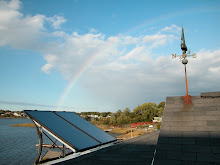According to the EPA, the average family of four in the U.S. uses about 400 gallons of water per day. Flushing your toilets uses 27%, your washing machine uses 22%, showering uses 17%, your faucets use 15%, leaks account for 14% and 5% is for other purposes. I'll give you some tips to save water in each of these areas.
Toilets: An older toilet can use 3.5-5 gallons per flush (GPF) compared to modern toilets which flush 1.6 GPF. If you have an older toilet and can not bear the cost of replacing it, you can cut down its usage by lowering the water level in the tank by adjusting the float. If tinkering is not your thing, you can simply displace some of the water in the tank by filling a glass jar with water (a 1/2 gallon milk bottle works well) and submerging it in the corner of the tank. If you want to conserve even more water, you might want to try a 1.4 or 1.28 GPF toilet. The 1.4 GP toilets are usually pressure-assisted, meaning they store water under pressure for flushing. Though very effective toilets, they are loud and might not be ideal for your home. The 1.28 GPF toilets are what are called "flapperless." They rely on a bucket that holds the water. When you flush the toilet, the bucket tips and a tidal wave of water flushes the toilet. I would shop for a toilet that is rated high in flushing performance because if you have to flush it twice, you aren't saving any water. Switching to a water conservation toilet can save 14,000 gallons per year over an older toilet and 8,000 over a 1.6GPF toilet. Also, installing a fill valve that limits the water entering the bowl during the refilling cycle can save thousands of gallons per year.
Washing Machines: I don't have much to say here that you probably already know. Buy an appliance with the Energy Star rating, make sure the machine is filled completely, use the proper wash size for the amount of clothes, and don't wash things that don't need to be washed.
Shower: A typical shower head uses 2.5 gallons per minute (GPM.) By switching to a 2GPM shower head, you can save 4,300 gallons per year. By switching to a 1.75GPM shower head, you can save 7,600 gallons each year. I caution that the flow from a 1.75GPM shower head seems "weaker" at first, but you get used to it. I have a 1.75GPM shower head in my bathroom.
Faucets: Most faucets have a standard 2.2GPM aerator screwed on the spout, though many have been removed or tampered with over the years. Changing your aerators is a simple, effective and inexpensive way to conserve water. You can purchase aerators with flow rates of 2.0, 1.75, 1.5, 1.0 and 0.5GPM, all offering savings over the standard 2.2GPM. I recommend using 0.5GPM aerators on your bathroom faucets for maximum savings and a 1.5GPM aerator on your kitchen sink faucet to save water when washing and rinsing while not sacrificing expediency in filling large pots for cooking. Following these recommendations can save you over 14,000 gallons per year. Also, put bottles of water in the refrigerator instead of running the water until it gets cold. When drawing hot water, consider installing a recirculation pump under your sink if it takes a long time for the water to get hot.
Leaks: A leak of one drip every second adds up to 3,000 gallons per year. You might not even know you have a leak. To test a toilet, add a few drops of food coloring to the tank before you go to bed. If the water in the bowl is colored in the morning, the toilet is running. Also, dry out the basins and spouts of your sinks and tubs and put a tissue under the spouts at night. The tissue will show if there were and drips overnight. Check your water meter. If it is spinning when you are not using water, you have a leak. If you don't have a water meter you can use a trick an old plumber showed me when I was an apprentice. Place the point of a pencil against your main water pipe and the eraser against your ear (not in your ear) and listen for a leak.
Other: Pretty vague...Lets call it outdoor usage. For watering your garden and lawn, I advise planting "rain gardens" and using rain water recovery barrels on your gutter downspouts to utilize water that is usually allowed to run off. If you have to water, do so in morning and evening when evaporation is less of a concern. If your sprinklers come on via a timer, shut the system off when rain is in the forecast. Don't leave the hose running when washing your car. Instead use a conservation-type sprayer head. Use a pool cover when you are not using your pool. The evaporation from a pool is tremendous, not to mention the loss of heat and chlorine.
If the average family follows these tips, they will save over 30,000 gallons per year. I am serious about water conservation. I hope you are too.
Subscribe to:
Post Comments (Atom)

No comments:
Post a Comment